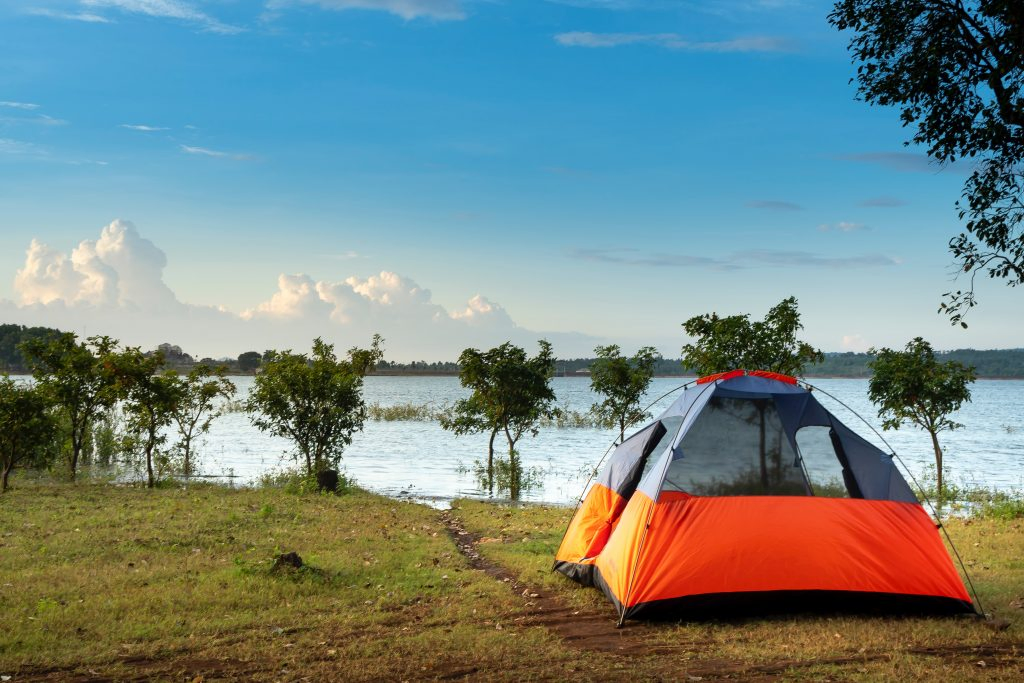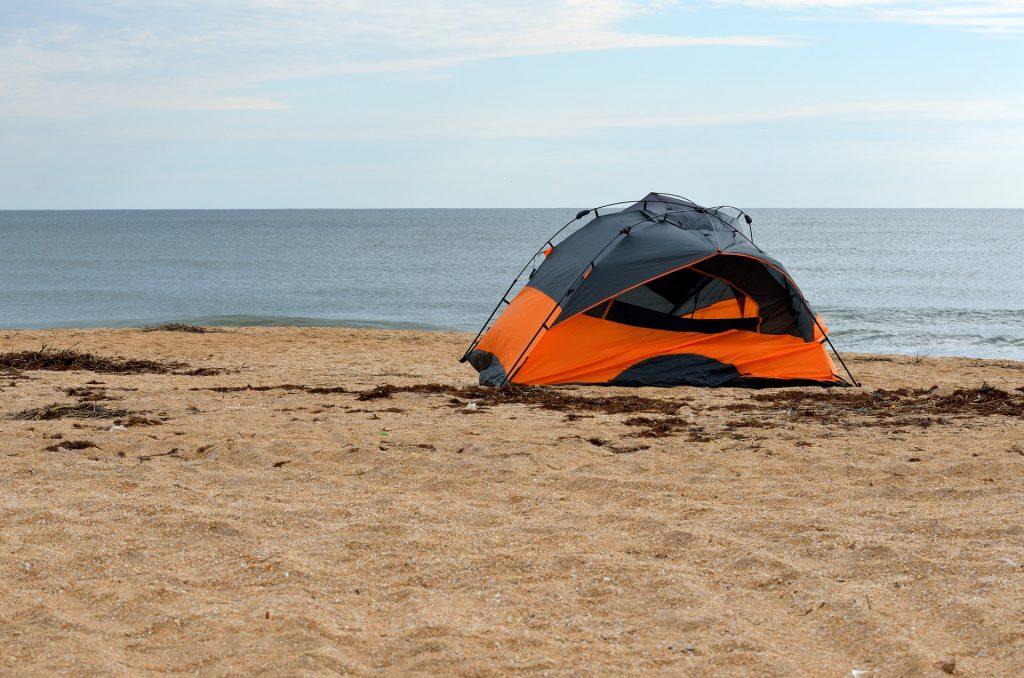Do you like to camp, no matter what the weather forecast says? Has your tent ever been ripped away by the strong wind? As any camping enthusiast knows, weather conditions can change rapidly in the great outdoors.
If you want to feel safe during a windstorm, or if you are preparing to camp on a breezy beach, you may be wondering how to select a high-wind tent and how to secure it in windy conditions.
This guide discusses what to look for when purchasing a tent and how to set it up effectively, so you can be prepared for any troublesome weather.
How to Secure Your Tent in Windy Conditions

When camping, you can be prepared for difficult weather if you know how to secure your tent in windy conditions. To combat windstorms, it’s important to purchase a high-wind tent and learn how to windproof a tent. Correct set-up will prevent damage or loss to your tent.
Follow the steps below to learn how to secure a tent in high winds and to make sure you’re ready with the right gear.
Important Note about Safety It’s always important to remember: safety first. Make sure you look out for tree branches or other debris which may become dangerous when airborne. You should know where to get help if needed, and where to find emergency shelter and supplies. You should always take a first-aid kit with you and tell a friend where you are camping and when you expect to return.
Can Tents Withstand Wind?

At this point, you may be wondering: “can tents withstand wind in the first place?” They certainly can, just as long as you have the right gear. You can find high-wind tents that are better suited for such conditions. Tents should also have a wind rating which will help you select one that matches your needs.
For avid campers who like to explore in the stormy season, there are specific features that make a tent better equipped to withstand high winds.
A smaller, low-profile tent may stand up more securely than a larger tent, due to a smaller surface area being exposed to the wind. However, be careful to avoid tents which are labeled ultra-light, as they are likely to be less durable. You should aim for a tent which is small but has a strong frame. Look for double-walled tents which are equipped with a strong outer shell.
Other features that increase wind resistance include sturdy tent poles, long stakes, a full-coverage rainfly, heavier fabrics such as canvas, and a low-to-the-ground configuration. The more stakes and poles a tent has, the better it is in windy conditions. Poles made from fiberglass will provide added weight. The door of the tent should seal completely shut, and there should be a door flap to shield from wind drag.
A few brands which produce high wind tents are Black Diamond, Teton Sports, and Mier.
Once you’ve chosen your tent, you can head to the campsite and begin set-up. Follow this guide which will walk you through the process.
More: 3 Season Tent Vs 4 Season Tent: Which Is Better?
How Do You Camp in Windy Conditions?
First, here are some important tips:
- Take extra guylines with you, and make sure you have plenty of sturdy stakes.
- Watch the weather forecast. Keep in mind that even the strongest of tents has a limit and it may not be able to withstand wind speeds above 50 miles per hour. If you are facing gale-force winds, it may be safer to postpone your camping trip till another time.
Location, Location, Location
Try to set up your tent in an area which will meet the least wind resistance. For example, try to set it up downwind from a ridge, a group of trees, a hedge of bushes, an outcrop of boulders, or buildings if possible. If you can find a valley, this may provide a natural windblock.
However, you should be careful and avoid setting up your tent near any dead trees, as broken branches caught in the wind can pose a serious safety hazard.
Once you’ve selected your location, make sure to orient the tent aerodynamically. You can do this by determining which way the wind is blowing. The lowest and narrowest side of the tent should face towards the wind. Avoid placing the tent’s opening in the direction of oncoming wind, because this may cause the tent to blow away easily as the wind swoops inside the tent.
Arrange the Poles
Assemble your tent poles first so that you can move through the following steps more quickly. As they are unlikely to blow away on their own, you can set the arranged tent poles aside for the time being.
More: How to Fix Pole Tent
Stake it Down
Stake down the windward side of the tent first. Make sure to hammer the stakes into the ground at a 45-degree-angle towards the tent body, rather than straight down, for added wind security. Fasten the poles to the windward corners which you staked first. Next, move to the opposite section of the tent and stake that down. Attach the tent poles on this side as well.
Make sure your stakes are deep into the ground and use every stake loop to prevent the wind from getting underneath the tent. If the stakes aren’t strong enough, if the ground isn’t ideal, or if you want additional security, you should use another form of anchoring, such as sand anchors or rocks. You can also use a small piece of bungee cord to add flexibility.
Next, attach the rest of the tent body to the pole structure. Now your tent has a basic shape.
Weigh it Down
Add weight to the inside of the tent by storing backpacks and other gear inside. This weight will prevent the tent structure from flying away while you finish setting up.
Secure the Rainfly
To set up the rainfly, drape it over the tent and attach the corners. Most rainflies are equipped with corner straps, which you can cinch periodically to make sure they’re in place. Secure each velcro wrap around the tent poles in order to add stability to the tent.
Next, check your tent structure. The rainfly should be tight, and the seams on the fly should line up evenly with the seams of the tent body.
Watch this YouTube video for a quick demonstration of the above steps:
Guy out the Tent
Guylines are strings or cords which attach to loops on the rainfly and are staked into the ground. These provide added security against the wind, even more so than tent poles.
Set up the guylines on all sides of the tent. Ensure that the external guylines are tight and facing in opposing directions to withstand the wind. Anchor each guyline a short distance away from the base of the tent for more strength and to prevent flapping. Make sure to pull each guyline tight for tension. The more guylines you use, the sturdier your tent structure will be.
Check out this video for a demonstration of how to properly set up guylines:
The guylines should follow the seams of the tent, as shown in this video:
If your tent is equipped with internal guylines, set these up too for further stability. Make sure to check and retighten the guylines periodically to prevent looseness.
Now You’re Ready to Face the Weather
As we’ve learned, it’s important to be wind-ready when planning a camping trip.
Be diligent and take the right gear with you, such as sturdy stakes and extra guylines, and make sure your tent is designed to withstand wind. Set up your tent behind a windbreak, be careful to stake and guy out your tent effectively and check the lines regularly for tightness.
Leave a comment with your thoughts or any questions you have about this tutorial. Let us know if you have any tips about camping in storms.
With these tips, you’re now ready to face the windy weather. Happy camping!



